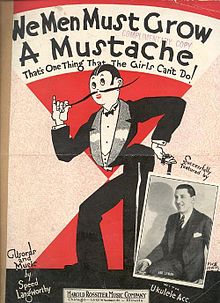Jazz Age: Difference between revisions
m Reverted edits by 216.166.199.218 to last revision by 66.167.45.116 (HG) |
No edit summary |
||
| Line 47: | Line 47: | ||
[[hu:Dzsesszkorszak]] |
[[hu:Dzsesszkorszak]] |
||
[[ja:ジャズ・エイジ]] |
[[ja:ジャズ・エイジ]] |
||
I C U |
|||
Revision as of 16:23, 11 January 2010
The Jazz Age describes the period after the end of World War I, through the Roaring Twenties, ending with the onset of the Great Depression. Traditional values of the previous period declined while the American stock market soared.
The age takes its name from jazz music, which saw a tremendous surge in popularity. Among the prominent concerns and trends of the period are the public embrace of technological developments typically seen as progress — cars, air travel and the telephone - as well as new modernist trends in social behavior, the arts, and culture. Central developments included Art Deco design and architecture.
The Jazz Age in literature
One of the most representative literary works of the Jazz age is American writer F. Scott Fitzgerald's The Great Gatsby (1925), which highlighted what some describe as the corruption of the post-WW I age as well as the growth of individualism. Fitzgerald is largely credited with coining the term "Jazz Age," which he used in such books as his short story collection Tales of the Jazz Age. His second novel, The Beautiful and Damned (1922), also deals with the era and its effect on a young married couple. Fitzgerald's last completed novel, Tender Is the Night (1934) takes place in the same decade but is set in France and Switzerland not New York, and consequently is not widely considered a Jazz Age novel per se.
Additional works on the Jazz Age might include Thomas Wolfe's titanic 1936 book Of Time and the River which takes its protagonist from the depths of the Carolinas to Harvard and Antarctica, and finally to New York City in the 1920s. Wolfe's You Can't Go Home Again is also relevant for its party scene on the night of the 1929 stock market crash. Edith Wharton's late novel Twilight Sleep, set in New York and written in 1927, is a great example of social critiques of Jazz Age values and lifestyles. Additionally, The Rosy Crucifixion trilogy by Henry Miller is set in New York during this period.
Limited social acceptance of minorities and homosexuals

- Masculine Female, feminine men!
- Which is the rooster, which is the hen?
(Leslie was a renowned critic of homosexual behavior, and a supporter of the prohibition movement.)
Homosexuals received a level of acceptance that was not seen again until the 1960s. Until the early 1930s, gay clubs were openly operated, commonly known as "pansy clubs". The relative liberalism of the decade is demonstrated by the fact that the actor William Haines, regularly named in newspapers and magazines as the number-one male box-office draw, openly lived in a gay relationship with his lover, Jimmie Shields.[2] Other popular gay actors/actresses of the decade included Alla Nazimova and Ramon Novarro.[3] In 1927, Mae West wrote a play about homosexuality called The Drag, and alluded to the work of Karl Heinrich Ulrichs. It was a box-office success. West regarded talking about sex as a basic human rights issue, and was also an early advocate of gay rights. With the return of conservatism in the 1930s, the public grew intolerant of homosexuality, and gay actors were forced to choose between retiring or agreeing to hide their sexuality.
References
- ^ A full reproduction of the original sheet music with the complete lyrics (including the cover sheet) can be found at: http://nla.gov.au/nla.mus-an6301650
- ^ Mann, William J., Wisecracker : the life and times of William Haines, Hollywood's first openly gay star. New York, N.Y., U.S.A. : Viking, 1998: 2-6.
- ^ Mann, William J., Wisecracker : the life and times of William Haines, Hollywood's first openly gay star. New York, N.Y., U.S.A. : Viking, 1998: 12-13, 80-83.
Further reading
- Allen, Frederick Lewis. Only Yesterday: An Informal History of the Nineteen-Twenties 1931.
- Gary Dean Best. The Dollar Decade: Mammon and the Machine in 1920s America Praeger Publishers, 2003.
- Dumenil, Lynn. The Modern Temper: American Culture and Society in the 1920s Hill and Wang, 1995
- Fass; Paula. The Damned and the Beautiful: American Youth in the 1920’s. Oxford University Press, 1977.
- David E. Kyvig; Daily Life in the United States, 1920-1939: Decades Promise and Pain Greenwood Press, 2002
- Leuchtenburg, William. The Perils of Prosperity, 1914–1932 University of Chicago Press, 1955.
- Lynd, Robert S., and Helen Merrill Lynd. Middletown: A Study in Modern American Culture Harcourt, Brace and World, 1929. famous sociological study of Muncie, Indiana, in 1920s
- Mowry; George E. ed. The Twenties: Fords, Flappers, & Fanatics Prentice-Hall, 1963 readings
- Parrish, Michael E. Anxious Decades: America in Prosperity and Depression, 1920–1941 W. W. Norton, 1992
- West, James [Carl Withers]. Plainville, U.S.A. Columbia University Press, 1945. sociology of life in a small town
External links
I C U
